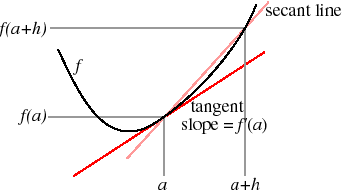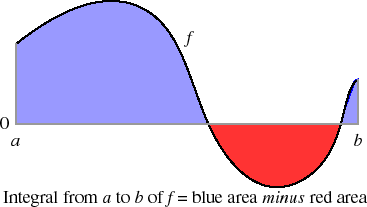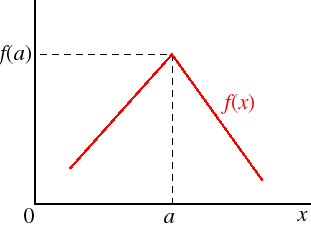1.4 Calculus: one variable
Differentiation
Let f be a function of a single variable defined on an open interval. This function is differentiable at the point a if it has a well-defined tangent at a. Its derivative at a, denoted f '(a), is the slope of this tangent.
Precisely, consider "secant lines" like the one from (a, f (a)) to (a + h, f (a + h)) in the following figure.

Such a line has slope ( f (a + h) − f (a))/h. The derivative of f at a is defined to be the limit, if it exists, of this slope as h decreases to zero.
|
Rules for differentiation
The definition of a derivative implies the following formulas for the derivative of specific functions, where a and k are constants.| f (x) | f '(x) | |
| k | 0 | |
| kxn | knxk−1 | |
| ln x | 1/x | |
| ex | ex | |
| ax | axln a | |
| cos x | −sin x | |
| sin x | cos x | |
| tan x | 1 + (tan x)2 | |
Three general rules (very important!!):
- Sum rule
- F (x) = f (x) + g(x): F '(x) = f '(x) + g'(x)
- Product rule
- F (x) = f (x)g(x): F '(x) = f '(x)g(x) + f (x)g'(x)
- Quotient rule
- F (x) = f (x)/g(x): F '(x) = [ f '(x)g(x) − f (x)g'(x)]/(g(x))2
f '(x)(g(x))−1 − f (x)(g(x))−2g'(x),which is equal to [ f '(x)g(x) − f (x)g'(x)]/(g(x))2.
|
|
|
Second derivatives
If the function f is differentiable at every point in some open interval I then its derivative f ' may itself be differentiable at points in this interval. If f ' is differentiable at x then we say that f is twice-differentiable, we call its derivative at x the second derivative of f at x, and we denote this derivative f "(x).Integration
Let f be a function of a single variable on the domain [a, b]. The definition of the ("definite") integral of f from a to b, denoted∫ba f (z)dz,is a measure of the area between the horizontal axis and the graph of f , between a and b.

Notes
- If f (x) < 0 for some x between a and b, then the corresponding areas (shaded red in the above figure) count negatively in the integral.
- The integral is defined precisely as the limit, if it exists, of approximations to the area consisting of sums of the areas of narrow rectangles as the width of these rectangles approaches zero. If the limit exists then f is integrable. It may be shown that if f is continuous then it is integrable. If f is not integrable, then its integral is not defined. (Such functions are fairly exotic. An example is the function f with domain [0, 1] defined by f (x) = 1 if x is a rational number and f (x) = 0 if x is an irrational number.)
- Note that the variable z is a dummy variable, and can be replaced by any other variable. Sometimes it is dropped entirely, and the integral is written simply as ∫ba f .
|
This result shows us how to calculate the integral of a function f : we need to find a function that, when differentiated, yields f .
The symbol
∫ f (x)dx,called the indefinite integral of f , denotes the set of functions F for which F ' = f . Why "set"? Because if F '(z) = f (z) for all z then for any function H with H(z) = F (z) + c, where c is a constant, we also have H'(z) = f (z) for all z. In honor of the constant c, we sometimes write statements like "∫2x dx = x2 + c", meaning that the derivative of the function x2 + c, for any value of c, is 2x.
For many functions, finding the indefinite integral is not easy. In fact, the integral of many functions cannot be written as an explicit formula.
Some integrals that may be expressed simply are
∫xndx = xn + 1/(n+1) + c,
∫exdx = ex + cand
∫(1/x)dx = ln |x| + c.A useful fact to employ when finding some integrals is that the derivative of ln f (x) is f '(x)/ f (x) (an implication of the chain rule, discussed later). Thus if you can express the function you are integrating in the form f '(x)/ f (x), its integral is ln f (x). For example,
∫
x
x2 + 1 dx = (1/2)ln (x2 + 1) + c.
Integration by parts
We can find the indefinite integral of some functions by using the result that∫ f (x)g'(x)dx = f (x)g(x) − ∫ f '(x)g(x)dx.This result follows from the product rule for differentiation. Define the function h by h(x) = f (x)g(x) for all x. Then h'(x) = f '(x)g(x) + f (x)g'(x), so that h(x) = f (x)g(x) = ∫ f '(x)g(x)dx + ∫ f (x)g'(x)dx.
This result is useful if we can express the function we want to integrate as a product f (x)g'(x) with the property that we can easily find the integral f '(x)g(x). The following example illustrates this point.
|
∫ab f (x)g'(x)dx = f (a)g(a) − f (b)g(b) − ∫ab f '(x)g(x)dx.


No comments:
Post a Comment